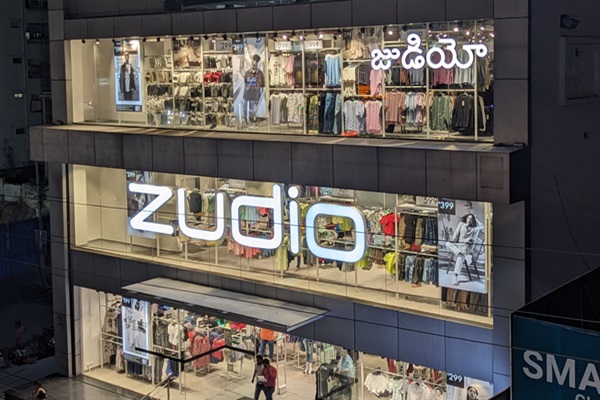.png)

Krishnadevan is Consulting Editor at BasisPoint Insight. He has worked in the equity markets, and been a journalist at ET, AFX News, Reuters TV and Cogencis.
June 23, 2025 at 9:28 AM IST
Trent’s latest annual investor day and the 2024-25 annual report have once again thrust the Tata Group’s retail arm into the market’s spotlight, and for good reason. The management’s target of a 25% CAGR in revenue over the medium term sounds audacious, but it’s not without precedent. Since 2018-19, Trent has multiplied its revenue 6.5 times, a feat that would make even the most aggressive retail strategists pause.
The Indian organised retail sector remains under-penetrated, and Trent’s leadership is betting that the runway is long and the wind is at its back. But with the stock trading at more than 100 times forward earnings, the question is can Trent’s execution keep up with its ambition, or is this again a case of valuation running ahead of reality?
The most striking takeaway from this year’s investor day is Trent’s knack for identifying and scaling new growth engines. Categories like beauty, innerwear, and footwear that were once afterthoughts now account for about a fifth of the company’s fashion business. And this growth isn’t recent froth. Over the last four years, beauty volumes have surged 40x, innerwear 13x, and footwear 9x. In 2024-25 alone, beauty sales shot up 65% to 81 million units, innerwear grew 47% to 50 million units, and footwear leapt 42% to 27 million units. Zudio’s footwear sales now even surpass those of established players like Metro and Campus. This isn’t just incremental growth; it’s a sign that Trent is disrupting the categories it enters.
Trent’s formula is deceptively simple, or so it appears. It’s to spot high-repeat, high-volume categories, go strong on private labels, and move fast. The launch of Zudio Beauty and the Pome lab-grown diamond jewellery line are new bets on this strategy. By selling exclusively through its own stores, Trent keeps a tight rein on brand experience and pricing. Store expansion is relentless with Zudio alone adding 220 new stores in 2024-25. It now has 765 stores in all, and has a target of 1,200 by 2026-27. Westside, the premium store brand, now has 248 stores. Westside has ensured that stores have character and each of the latest stores span 20,000–30,000 square feet, offering premium experiences and justify a higher average selling price.
Weighty Growth
But Trent isn’t just chasing new cities. Its “cluster” strategy focuses on deepening presence in micro-markets, building density and recall. A downside to it could be that same-store sales growth turned negative last year, a reminder that growing fast can sometimes mean cannibalising your own base. But Westside isn’t entirely at the mercy of footfall volatility as over 90% of its revenue now comes from loyalty programme members, who rose 38% to 16.4 million. The management is betting that the benefits of scale and local dominance will outweigh these short-term pains.
Behind this geographic expansion lies a quietly ruthless technology backbone. RFID tagging, automated distribution centres, and a complete SAP overhaul ensure inventory flows as fast as demand moves. With over 10,000 on the move stock units to manage, the company could well be a logistics firm as much as it is a fashion brand.
The Star grocery business, often where retail dreams in India get crushed, is finally finding its feet. Star now gets 73% of sales from its own brands, aiming for 80-85%, and posted 25% revenue growth in 2024-25. But it’s still EBITDA-negative, proof that not every Trent experiment is an overnight success. Still, the company remains bullish and sees Star as a sensibly scaled bet with long-term upside.
Financially, Trent’s numbers are hard to argue with. Standalone revenue jumped nearly 40% to ₹167 billion, EBITDA margins are a healthy 16.5%, and return on equity is north of 30%. The debt level is negligible. These are the kind of metrics that make investors swoon, especially in a market as cutthroat as Indian retail. Yet, at 128 times 2024-2025 earnings, Trent shares are fully priced. Bulls say the company’s execution, brand strength, and growth runway justify the premium.
Brokerages Goldman Sachs and Motilal Oswal see another 20% upside, valuing the stock at 55–60 times future earnings. Skeptics like Kotak Securities warn that any stumble like persistent negative same-store sales, a slower turnaround at Star, or a broader demand slowdown could trigger a sharp correction, with their fair value estimate a full 20% below current levels.
The management is betting on momentum and Goldman sees Zudio’s market share more than doubling to 3.5%, while Morgan Stanley flags a bold 10x long-term revenue estimate for Trent. Meanwhile, Zudio has taken its first step abroad, launching in the UAE, with early buzz not just from the Indian diaspora. A Westside abroad may not be far behind.
Trent’s cluster-led expansion, category innovation, and tech-driven supply chain are the envy of the sector, but the law of large numbers is an unforgiving adversary. Maintaining 25% growth as the base balloons will be a tall order. Can Trent revive same-store sales, further scale its emerging categories, and finally turn Star profitable? At these valuations, the market is betting that Trent can continue to defy gravity. For now, Trent remains the poster child of India’s organised retail revolution. But as any seasoned investor knows, the higher you soar, the greater the test of staying aloft.




